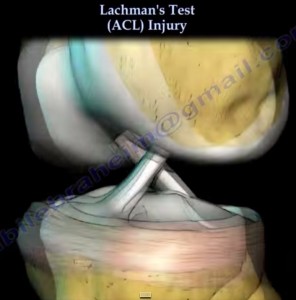Courtesy: Prof NabileEbraheim, University of Toledo, Ohio, USA
LACHMAN’S TEST
(ACL) INJURY
- Lachman’s test is the most sensitive examination test for ACL injury
- The anterior cruciate ligament is located in front of the knee.
- The ACL keeps the tibia from sliding out in front of the femur and provides rotational stability to the knee.
- Rupture of the anterior cruciate ligament is a condition commonly seen in sports due to a non-contact pivoting injury.
Patient evaluation
• Patient will feel a “POP” within the knee
• Pain
• Immediate swelling
• There is usually hemorrhaging within the knee joint
• Knee giving way
- If aspiration of the knee shows hemarthrosis, then there is a 75% chance of an ACL tear and meniscal injury
How do you perform the Lachman’s test?
- The patient should be lying supine and completely relaxed.
- Make sure that the patient’s hip muscles, quadriceps, and hamstring muscles are all relaxed
- Bend the knee to about 20-30 degrees
- Stabilize the femur with one hand and with the other hand, pull the tibia anteriorly and posteriorly against the femur.
- With an intact ACL, as the tibia is pulled forward, the examiner should feel an end point.
- The examiner should feel a firm end point.
- With a rupture, the ACL will be lax and the examination will feel softer with no end point.
- The tibia can be pulled forward more than normal (anterior translation).
- Lachman’s test is the best examination to diagnose a tear of the ACL.
- Be aware that a PCL tear may give posterior subluxation of the tibia and a false positive Lachman’s test.
Radiological examination
- MRI of the knee joint shows bone lesions or bruising associated with tears of the ACL.
- These injuries typically located at the middle of the femoral condyle and posterior part of the tibia laterally.

Very very good clip
Thank you .very clear